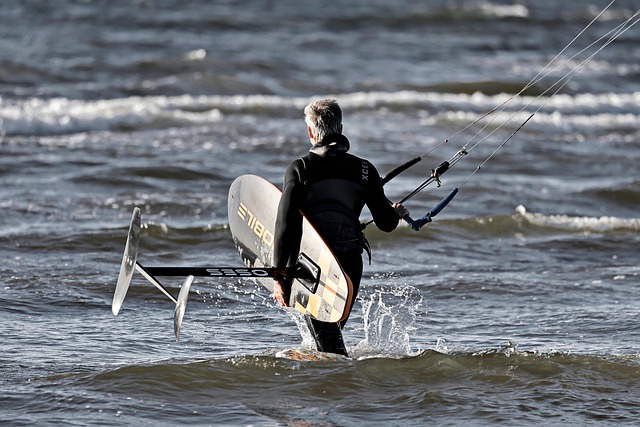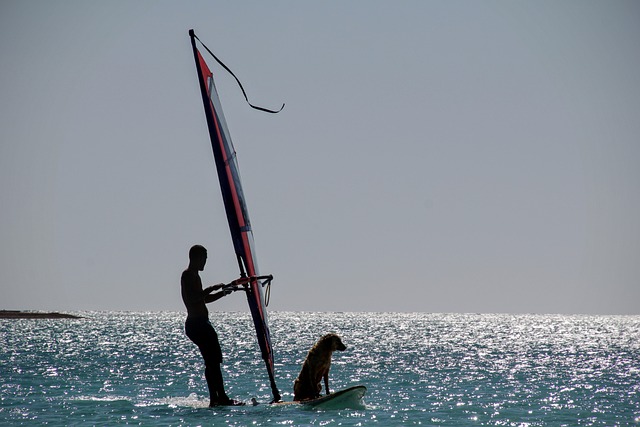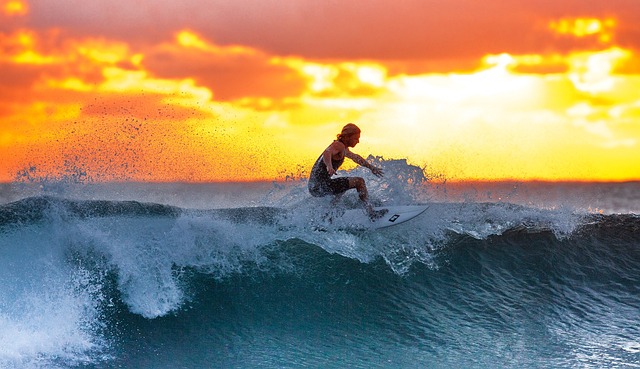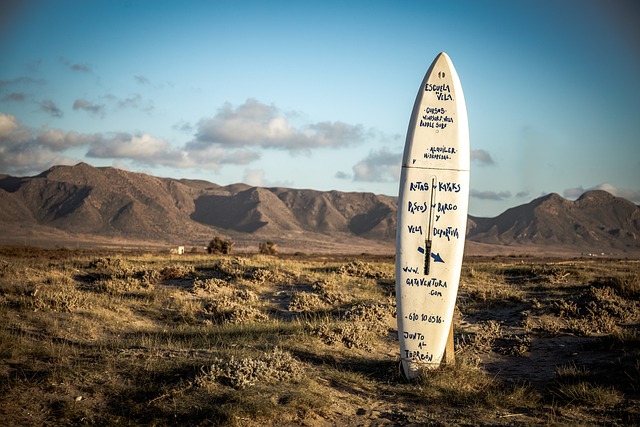Choosing the right surfboard as a beginner is crucial for a positive and progressive surfing experience. Key factors include understanding local wave types (beach, point, reef breaks), selecting board length & shape for stability and maneuverability, considering fin setups for control and balance, and prioritizing safety features like wider tails/noses for easier turns. Beginner-friendly boards are designed to adapt to various conditions, offering stability and ease of use for newcomers to focus on learning without gear constraints. Versatile all-purpose surfboards are ideal, providing a "golden ticket" for beginners to conquer diverse waves and grow their surfing skills.
Introducing our comprehensive guide on choosing the perfect surfboard for beginners, designed to cater to all wave types. Whether you’re tackling gentle ripples or facing formidable swells, understanding different wave types and selecting the right board is key to a thrilling surfing experience. Learn about crucial factors, benefits of versatility, essential features, and popular designs tailored for newcomers. Discover real-life success stories and expert tips to maximize your enjoyment on the waves. Start your surfing journey with confidence!
Understanding Different Wave Types: A Beginner's Guide

Understanding different wave types is a crucial first step for any beginner surfer. The ocean’s waves come in various shapes and sizes, each with its unique characteristics and behaviors. Generally, they can be categorized into three main types: beach breaks, point breaks, and reef breaks. Beach breaks occur when waves roll onto a shallow shore, creating a smooth, long ride suitable for beginners to catch their first waves. Point breaks, on the other hand, form along a jagged coastline, resulting in powerful, fast-moving waves that can be more challenging but offer exhilarating rides. Reef breaks involve waves breaking over underwater reefs or rocks, creating complex and often tube-like waves that are sought after by experienced surfers.
For a surfboard for beginners, choosing one designed to handle multiple wave types is essential. Shortboards, typically ranging from 5 to 7 feet in length, are versatile and excellent for learning how to turn and perform basic maneuvers. They work well on smaller beach breaks and can also catch larger waves at points or reefs if the conditions are right. Longboards, usually 9 feet or longer, provide stability and allow beginners to glide along smooth waves, making them ideal for practicing balance and catching more gentle beach breaks. Many beginner surfboards feature hybrid shapes that combine elements of both shortboards and longboards, offering the best of both worlds in terms of versatility and performance.
Key Factors in Choosing the Right Surfboard

When selecting a surfboard, especially as a beginner, understanding your wave conditions and personal abilities is key. The right board can transform an average surf session into a thrilling experience, while an ill-fitting one might leave you frustrated. Firstly, consider the type of waves you’ll be riding; are they gentle breaks suitable for longboards, or more powerful and fast, demanding shorter boards? Your wave knowledge will guide you in choosing the appropriate length and shape.
For beginners, a surfboard with a wider nose and tail offers stability and makes catching waves easier. This design provides better balance, allowing you to paddle out and stand up with confidence. Look for boards with a moderate rocker (flex) that helps with maneuvers and turning, ensuring a beginner-friendly experience. Additionally, consider the fin setup; triangular fins offer more control, while quad fins provide superior stability, catering to different skill levels and wave preferences.
Benefits of a Versatile Surfboard for New Surfers

For new surfers, finding the right surfboard can make or break their experience. A versatile board designed to suit all wave types is an excellent choice for those just starting out. These boards offer numerous advantages that cater specifically to beginners’ needs and skill levels. Firstly, they provide stability and ease of manoeuvre, allowing newcomers to focus on learning fundamental surfing techniques without worrying about the board’s performance in varying conditions. This versatility means new surfers can enjoy a consistent experience, no matter if they’re catching small waves at the beach or experiencing larger swells out at sea.
Additionally, a surfboard suitable for all wave types often incorporates design features that enhance learnability. These may include wider tails and noses, providing more stability and making it easier to turn and maintain balance. Such boards also typically have softer flex patterns, which offer a smoother ride and reduce the risk of injuries commonly associated with harder boards. By choosing a board that can adapt to different wave conditions, beginners can gain confidence and improve their skills faster, ultimately enjoying the sport more.
Features to Look For: Suited for All Waves

When looking for a surfboard that’s suited for all wave types, especially for beginners, there are several key features to consider. First and foremost, stability is paramount. A board with a wider shape offers better balance, making it easier for new surfers to catch waves and stand up. Look for boards with a volume that’s suitable for smaller wave conditions; this will provide ample floatation without overwhelming the rider in gentle waves.
Additionally, consider a design with a smooth contour and a blend of rocker profiles. This combination allows for easy paddling, efficient turns, and reliable performance across various swell sizes. A versatile fin setup is another important factor—choose boards with removable fins to adapt to different surfing styles and wave conditions. This adaptability ensures that your surfboard can grow with you as you progress from beginner to more advanced surfer.
How to Determine Your Wave Conditions

Choosing the right surfboard largely depends on understanding your wave conditions. For a beginner looking for a surfboard suitable for all wave types, start by assessing where and when you typically surf. Coastal areas with consistent waves, like coastal points and beaches, often offer a mix of smaller, gentler waves ideal for learners. In contrast, reef breaks and point breaks can generate faster, more powerful waves better suited to experienced surfers.
Next, consider the wave size range you usually encounter. Smaller waves generally offer slower speeds and less challenging conditions, making them perfect for beginners. Mid-sized waves provide a balance between learning opportunities and thrill. Finally, understanding the wave period (the time between peaks) is key. Longer periods allow for easier paddling and more time to catch your breath, while shorter periods require quicker reactions.
Popular Surfboard Designs for Beginners

For novice surfers looking to catch their first waves, choosing the right surfboard is essential. Popular designs are typically shorter and wider, offering greater stability and an easier learning curve. These boards often feature rounded pins or nose shapes that reduce the risk of snapping them on rough surfaces, making them ideal for beginners navigating choppy waters. Additionally, they have softer fins that provide better control and turn responsiveness, allowing newbies to focus on balancing and catching waves without worrying about complex board handling.
Case Studies: Real-Life Success Stories with All-Purpose Boards

In the realm of surfing, finding a versatile surfboard that suits all wave types is akin to striking gold—a game changer for surfers of all levels, especially beginners looking to conquer various ocean conditions. Case in point: numerous real-life success stories of novice surfers who have mastered their craft with an all-purpose board. These tales serve as living testaments to the versatility and adaptability these boards offer.
Take, for instance, the story of Sarah, a beginner surfer who found her confidence on a 9′ longboard designed for nosering and carving. Its stability allowed her to learn the art of catching waves consistently, even in modest surf conditions. Similarly, Mike, another newbie, discovered that a mid-length fish board, with its maneuverability and speed, was perfect for both small, gentle waves and larger, more powerful swells. These stories illustrate how all-purpose boards democratize surfing, enabling beginners to explore the ocean without being hindered by wave type or skill level.
Tips for Getting the Most Out of Your Board

Choosing the right surfboard is a game-changer for any beginner, offering a more enjoyable and safer surfing experience. When selecting your first board, consider its versatility to handle various wave types. A great tip is to opt for a mid-length board; these are incredibly versatile and suitable for small to medium waves, providing stability and maneuverability. Longer boards can be ideal for beginners as they offer more floatation, making it easier to catch waves.
For optimal performance, focus on finding a balance between length and width. Wider boards provide better stability but may be less agile, while narrower ones are typically faster and more responsive. Remember, the right board should adapt to your skill level and the local wave conditions, allowing you to grow and progress as a surfer.
Conclusion (Omitted as per instructions, but could include a call to action to read more about surfing gear)

For newcomers to the world of waves, selecting the ideal surfboard is a pivotal first step. A board designed for all wave types ensures versatility and accessibility across various conditions, making it perfect for beginners looking to explore the ocean’s offerings. This adaptability allows surfers to progress at their own pace, whether riding gentle rollers or tackling more challenging breaks.
Investing in a surfboard that caters to multiple wave scenarios provides an exceptional foundation for skill development. By choosing a board that suits your every adventure, you can focus on mastering techniques without constantly worrying about gear limitations. So, whether you’re aiming to catch your first few waves or simply enjoy the thrill of riding diverse breaks, consider a surfboard crafted for all conditions – the key to unlocking an unforgettable surfing journey. Read more about choosing the right equipment to elevate your surfing experience.
